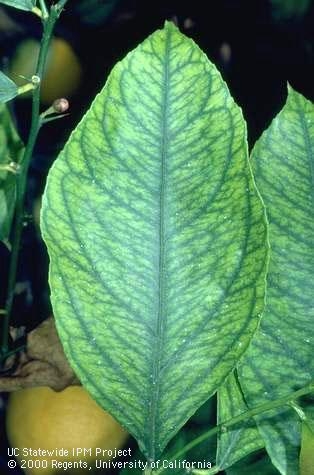- Author: Mark Freeman
Vertebrate pests that have caused damage to citrus trees include rodents and small mammals, large mammals, and birds. Citrus orchards provide food and shelter for a number of these pests, and damage may be severe if the pest resides in the orchard. Damage can occur to the fruit such as rat chewing or bird droppings. Bark damage and tree death can occur from rodents and larger mammals. Damage to irrigation systems such as chewing on hoses can easily be the most expensive damage.
The goals of a successful management program include reducing the number of pest problems and using control methods that are affordable. There are four key points to establishing and maintaining a vertebrate pest management program. First, one must identify the specific damaging species. Second, review all the management control options. Third, one must take action quickly and early, and use the best option that is appropriate for the time of year and the orchard. Fourth, use a monitoring system to detect when re-infestation occurs and thus more controls are needed.
The first key point is identification and observation. Many of the agricultural commissioners’ offices in the counties can help with this problem. In addition, University of California Production Manuals such as almond and walnut have reference material on different pests. It is critical to identify the specific species or type of pest causing damage. You can use direct observations with some pests such as birds or squirrels that are active during the day. With pests that are active at night or tend to hide, one looks for tracks, burrows, or the type of feeding; or one can use traps. With rodents, one can use the size of the incisor marks on plants to help identify the pest. This is also useful on irrigation systems, where one can remove the damaged part and take it to an expert. Traps are also used where trails are established to capture and identify the pest. Pictures, especially close-ups are very useful and can be emailed or sent to experts on the Internet. If you also describe the adjacent habitat such as foothills, streams or rivers, etc., that information will help.
For some pests, there are many possible control options. It is very important to check with the agricultural commissioner’s office as animals vary by protected status and how the animal can be legally controlled. The pest’s life cycle will determine when and if a certain control method can be used. For example, ground squirrels can be controlled effectively with poisoned baits but not in early spring when the animal is feeding on green material. Gophers can be controlled all year with poisoned baits that are applied into the burrows, but are more active when the soil is moist. Habitat modification may be an economical option, as brush piles near an orchard will provide shelter for pests. Biological control such as attracting owls and hawks to an orchard can assist with control, but seldom keeps rodent levels below economic levels.
It is important to act quickly when a control measure is selected. Some vertebrate pests can increase in population quickly, and control is less expensive with lower numbers of pests. Some pests will reside in the orchard, and create a home there. It is much easier to control them when the pests live outside the orchard.
Finally, it is important to have a monitoring system in place after controlling a vertebrate pest so as to detect if the pest is re-entering the orchard. A good record system is important.
Many of the citrus orchards in the San Joaquin Valley (SJV) are located near the foothills on the eastern side. Some of the more common vertebrate pests include gophers, ground and tree squirrels, mice, rats, rabbit, coyote, feral (wild) hogs, and starlings. Rare tree damage has occurred from bear and beaver. There is more new acreage in the SJV planted in the middle of the valley. Those trees will be susceptible to the vertebrate pests already found nearby.
Rodents such as gophers and meadow mice (or voles) feed on plant roots, and can girdle and kill young citrus trees. Occasionally, gophers can kill mature trees, especially if the tree is weakened by other factors such as root rot. Many members of the rat family and deer mice will feed on citrus fruit. The effectiveness of control measures depends on identifying the specific rodent. The Eastern Fox Squirrel (EFS) is a tree squirrel found near big cities in the SJV and throughout the metropolitan areas of Southern California. It has moved to adjacent commercial citrus orchards and will feed on ripe fruit.
Coyotes, rabbits, and squirrels will damage irrigation hoses. By examining the damage, experts can identify the pest. The EFS has caused considerable damage to irrigation systems in some nut crop orchards in the Fresno area.
Larger mammals can be economic pests. Wild hogs will feed on fruit, damage bark, and create large holes or “wallows” on the orchard floor where it is moist. Occasionally, hogs will destroy irrigation hoses. Beavers have destroyed young citrus trees located near streams.
Bird problems have occurred mainly due to large flocks of starlings that nested in orchards at night. The damage resulted from the bird droppings on the fruit.
More information about vertebrate pests can be found here.
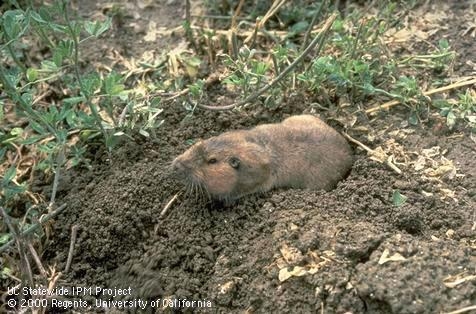
- Posted By: Chris M. Webb
- Written by: Larry Lindgren, Grower and Ben Faber, Farm Advisor
There are many changes going on in the citrus industry and one opportunity is the conversion of an orchard to another variety of citrus. If this is a consideration, then the question becomes one of whether the orchard should be topworked or replanted with new nursery trees. If the trees are healthy and under 20 years of age (it is possible to topwork older trees) and the new scion is compatible with the interstock or rootstock, then topworking can come into production sooner than a new replant. If the planting density needs to be changed or serious soil preparation or a new irrigation system needs to be installed, then replanting might be the preferred choice.
The chance to convert is also dependent on the availability of new trees and budwood. New varieties can often be in short supply. It’s best to make sure that for either option that the material is there. For topworking, T-budding is more conservative of material than stick grafting. If topworking is chosen, then it must be decided whether to graft the scaffold branches or the stump. Stump grafting makes for a lower tree, but scaffold grafting reduces the risk of losing the topworked tree from damage to the graft from birds, pests, wind or frost.
It is often assumed that topworking is cheaper than replanting, but as the following example shows, it probably is not. In Santa Paula, ‘Olinda’ Valencias on ‘Carrizo’ rootstock were converted to scions ‘Allen’ Eureka lemon, or ‘Powell’ late navel. In 1998 and 2000, the ‘Olinda’s were interplanted with either ‘Allen’ on ‘Macrophylla’ or late navel ‘Powell’ or ‘Chislett’ (on either ‘Carrizo or ‘C-35’ rootstocks). The ‘Olinda’s were topworked in 2002 and 2003 to one of the new scions. In a few cases, ‘Allen’ was stump grafted, but most trees were scaffold grafted.
Several steps are required for topworking that will ensure success. These are listed below:
• Get a reputable person to do the work.
• Time of year is critical for grafting. Spring is best.
• Leave a nurse limb.
• Decide to stump or scaffold graft.
o Stump grafting requires only 3 – 4 buds or sticks
o Scaffold grafting requires 2 buds per scaffold. Consider winds since even one-year old unions are very tender.
• Sequence of events
o Line up budwood
o Remove top of tree and stack brush
o Whitewash trunks
o Paint cutoff surfaces
o Insert grafts
o Wrap grafts with plastic tape
o Place white paper bag over grafts and tape in place
Later
o Keep after ants and snails
o Shred brush
o Remove bags when shoots start growing through them.
o Bi-monthly, in first year, brush out water sprouts. Less often in the next 2 years
Much of this work can be contracted with the grafter, who usually assures some level of performance, something like 90% take. It is up to the grower to ensure that pests do not take out the grafts.
The costs of topworking are associated with the costs of the budwood (as much as $3 per tree), the act of grafting (depending on stump or scaffold, $8-10 per tree) and water sprout removal. Sprout removal is six times in year one, eight times in year two and only four times in year three. At a labor rate of $12 per hour, sprout removal costs $7.20 per tree.
A like for like comparison of topworking versus replanting based on 2002 data is shown below.
So in the case of both the lemon and navels it costs a bit more to topwork, but the results are earlier production. Here the topworked trees gain the economic advantage. For example, if cultural costs were $1000 per acre per year (20 by 20 ft. spacing) and, conservatively, two years are saved, the maintenance savings per tree would be $18. In the above study the time advantage appears even greater. Three-year old topworked lemons produce about the same as 6-year old replants. Two year old topworked navels have a significantly larger canopy than six-year old replant navels and appear to have about the same fruit set for the coming year.

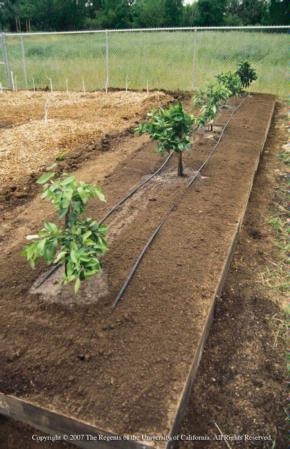
- Posted By: Chris M. Webb
- Written by: Neil O’Connell, Farm Advisor
Deficit irrigation research by Dr.David Goldhamer has yielded some interesting results in navel oranges. In the original trial on mature, vigorous Frost Nucellar navels on a sandy loam soil, applied water was reduced by varying amounts and at different times during the irrigation season depending upon the treatment imposed. Regulated deficit irrigation is applying a fixed % less than the full water requirement of the tree during a specific period in the irrigation season.
The fully irrigated control trees received a volume of water estimated to be the tree water requirements based upon size and current weather conditions –using the current water requirements of a pasture grass (Eto cimis station) multiplied by a crop factor for mature citrus which is 0.65. The objective of the trial was to determine if the volume of applied water could be reduced by varying amounts and at different times during the irrigation season compared to a fully irrigated control without a loss in yield or quality and perhaps improved peel appearance. Measurements were made of fruit growth during the season and of yield and fruit quality at harvest; the amount of water applied with each treatment was measured as well. Research conducted over the years has indicated that citrus was sensitive to reduced irrigation particularly at petal fall and during early fruit development with loss in yield or fruit size.
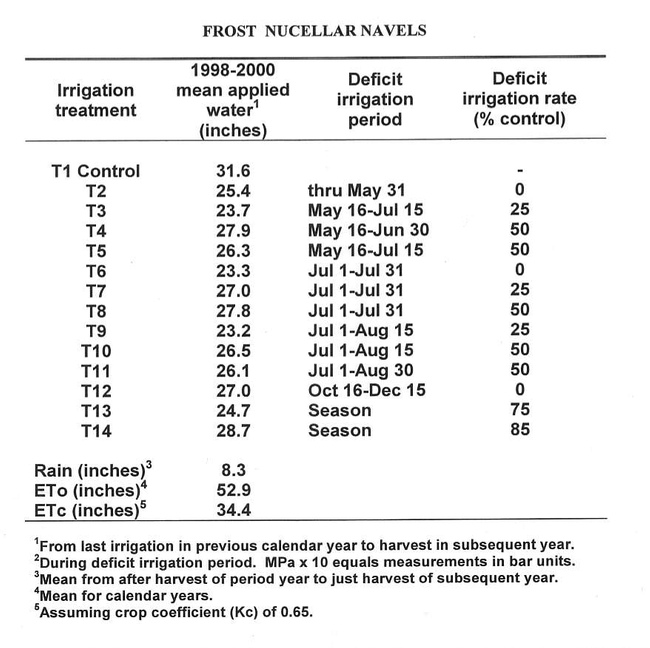
The current study indicated that where deficit irrigation was applied, a slowing in growth rate of the fruit was observed compared to the fully irrigated tree, but when full irrigation was resumed at the end of the treatment period, accelerated growth occurred compared to the control trees. Yield at harvest was not significantly different among any of the reduced irrigation treatments compared to the fully irrigated control trees. There was also no difference in number of fruit per tree or packable cartons among the treatments compared to the control. An additional result was that there was significantly less creasing of the peel in two of the treatments--T2 and T3-- compared to the fully irrigated trees. Both of these treatments imposed stress early in the season and reduced applied water by 6.2 and 7.9 inches, respectively. This equates to 19.6 and 22.8% less applied water than the fully irrigated control. This research demonstrated that less than the full water requirements of the tree can be applied at specific times during the fruit development period under controlled and known conditions without a loss in yield.
Ongoing research on Lane Late navels is being conducted with the object of reducing granulation by regulating fruit size for an optimum fruit size at harvest. Fruit held late for harvest frequently results in a significant portion of the fruit being large. Historically large fruit have a higher percentage of the fruit with granulation. This fruit may be less than optimum size (too large) for current market conditions as well. Based upon the previous regulated deficit irrigation study the object of the current trial is to regulate size based upon imposed stress by applying less than full irrigation during specific periods in the irrigation season that is early, mid and late season stress.
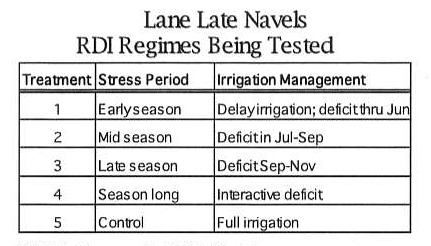
Less water is applied than required by a fully irrigated tree for the period, and growth of the fruit is monitored compared to the fully irrigated tree. Adjustments are made in applied water based upon the growth of the fruit in the stress tree as well as measured tree water status (pressure chamber) compared to the fully irrigated control. The same type of response to the deficit irrigation that occurred with the Frost Nucellar has been observed. A slowing of growth under the deficit irrigation, then accelerated growth with resumption of full irrigation. However, this study imposes stress over longer periods that the previous study and thus, the desired reductions in fruit size at harvest have occurred in all but the T1 treatments. The first year of the study, when fruit loads were relatively high, showed that early season stress reduced granulation (6.5% for all sizes vs. 17% for the control) with no effect on size. Continuous stress reduced both granulation (mean of 3.8 for all sizes vs. 17% for the control) and fruit size. In the second study year with lower fruit loads, there was no reduction in fruit load but fruit size was reduced to a greater extent in the mid, late summer, and continuous stress treatments. This reduced the percentage of unwanted very large size (24 and 32 count) fruit such that revenue to the grower was higher by from $1300 to $3000 per acre, depending on whether 24s and 32s were considered marketable.
Deficit irrigation imposes a level of stress on the tree related to the amount of water that the tree is shorted compared to a fully irrigated tree. The tolerance of the tree to this stress is related to the vigor of the tree, the period in the fruit development cycle, weather conditions, and how long the stress continues, and the magnitude of the stress. Under the conditions of these studies the level of stress imposed is carefully monitored and the deficit irrigation treatments are under known conditions and are carefully controlled. Where conditions are not known by the grower the trees may already be under some stress, the vigor of the trees may not be high; the irrigation system may not be uniform and therefore not delivering the expected volume. Attempting deficit irrigation under these circumstances runs the risk of reducing yield perhaps seriously as well as fruit size.
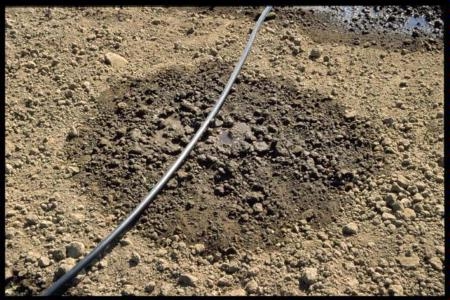
- Author: Neil V O'Connell
Recently a six-year old W. Murcott orchard was evaluated for causes of tree decline. A high percentage of the trees exhibited damage to the bark of the tree generally from the soil line up 6-8 inches. (Fig.2) In some instances the tree had been almost totally girdled. On close inspection of the trunk, an open hole 4-5 inches in diameter was found at the base of the tree. (Fig.3)
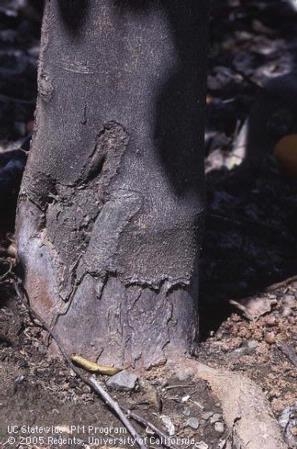
Microtus are often found where there is grass cover. They generally do not invade cultivated crops until the crop is tall enough to provide food and shelter. Meadow mice are active all year round. They forage at any time during the day or night but are chiefly nocturnal. They are usually found in colonies marked by numerous -2-- inch wide surface runways though matted grass. Small piles of brownish feces and short pieces of grass stems along the runways are evidence of activity. The burrows consist of extensive underground tunnels, nest chambers and storage chambers. Home range is typically small, less than a 60 foot radius in the case of “M.californicus”. All meadow mice swim well. Therefore, irrigation ditches will not serve as effective barriers against meadow mice movement into fields. Meadow mice may forage beyond the sheltered runways. Food consists of tubers, roots, seeds, grain, and succulent stems and leaves.
Females breed at 4 to 6 weeks of age with liter size of “M.californicus” averaging around 4. Under natural conditions a female Microtus may produce from 5 to 10 litters a year. The major breeding season corresponds with the season of forage growth. Microtus populations build up to a peak every 3 to 4 years, followed by a rapid decline during the next breeding season. The exact causes of the cycle of buildup and decline are not known, though disease, food shortages, physiological stress from overcrowding, and other factors may be involved. It is assumed that in cultivated areas Microtus populations are permanently based in favorable habitat such as roadsides, canal banks or adjacent noncultivated land. Invasion of cultivated cropland occurs when the population builds up or when the wild habitat becomes unfavorable. Coyotes, badgers, weasels, snakes, hawks, owls, herons and gulls are among the principal predators. It is believed that predators are not able to prevent or control a population eruption because of the birth rate of the fast breeding Microtus population. Meadow mice are classified as nongame mammals by the California Fish and Game Code. Nongame mammals, which are found to be injuring growing crops may be taken at any time or in any manner by the owner. Management: The most effective management options in an orchard situation are a reduction in ground cover and the use of toxic baits. Meadow mice are cover dependent. If cover is the management of choice - typically weed or grass, the cover can be removed from around the base of a tree, this often solves meadow mice problems. In situations where cover removal is not possible or is insufficient to solve the problem, the next best option is the use of toxic baits. Many bait carriers are used (e.g., oat groats, wheat bait). Baits: Crimped oat groats is the most satisfactory bait although crimped whole oats are used (e.g., oat groats, wheat grains, pelletized formulations, etc., but crimped oat groats have typically been most effective). The primary toxicants used for meadow mouse control include zinc phosphide, diphacinone, and chlorophacinone. Directions for management including baiting can be obtained by contacting the Agricultural Commissioner’s Office.
* Portions taken from J.P.Clark Vertebrate Pest Control
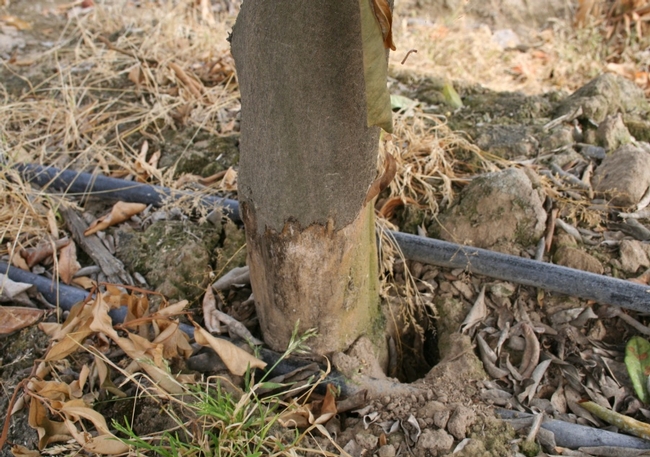
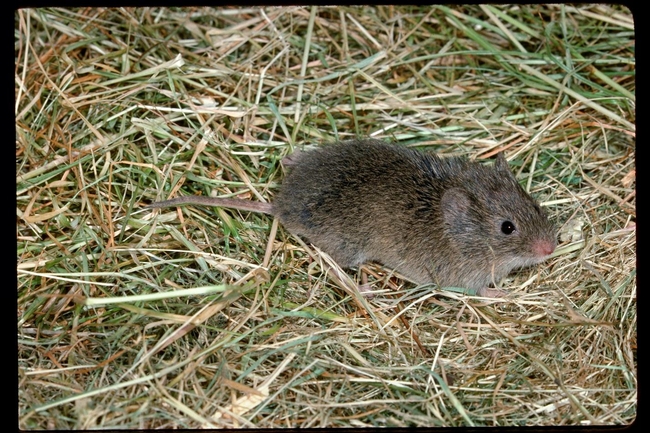
- Written by: Craig Kallsen
University of California (UC) researchers and private industry consultants have invested much effort in correlating optimal citrus tree growth, fruit quality and yield to concentrations of necessary plant nutrients in citrus (especially orange) leaf tissue. The grower can remove much of the guesswork of fertilization by adhering to UC recommendations of critical levels of nutrients in the tissues of appropriately sampled leaves. Optimal values for elements important in plant nutrition are presented on a dry-weight basis in Table 1. Adding them in appropriate rates by broadcasting to the soil, fertigating through the irrigation system or spraying them foliarly may correct concentrations of nutrients in the deficient or low range. Compared to the cost of fertilizers, and the loss of fruit yield and quality that can occur as a result of nutrient deficiencies or excesses, leaf tissue analysis is a bargain. At a minimum, the grower should monitor the nitrogen status of the grove through tissue sampling on an annual basis.
Leaves of the spring flush are sampled during the time period from about August 15 through October 15. Pick healthy, undamaged leaves that are 4-6 months old on non-fruiting branches. Select leaves that reflect the average size leaf for the spring flush and do not pick the terminal leaf of a branch. Typically 75 to 100 leaves from a uniform 20- acre block of citrus are sufficient for testing. Generally, the sampler will walk diagonally across the area to be sampled, and randomly pick leaves, one per tree. Leaves should be taken so that the final sample includes roughly the same number of leaves from each of the four quadrants of the tree canopy. Values in Table 1 will not reflect the nutritional status of the orchard if these sampling guidelines are not followed. Typically, citrus is able to store considerable quantities of nutrients in the tree. Sampling leaves from trees more frequently than once a year in the fall is usually unnecessary. A single annual sample in the fall provides ample time for detecting and correcting developing deficiencies.
Table 1. Mineral nutrition standards for leaves from mature orange trees based on dry-weight concentration of elements in 4 to 7 month old spring flush leaves from non-fruiting branch terminals.
|
element |
unit |
deficiency |
low |
optimum |
high |
excess |
|
|
|
|
|
|
|
|
|
N |
% |
2.2 |
2.2-2.4 |
2.5-2.7 |
2.7-2.8 |
3.0 |
|
P |
% |
0.9 |
0.9-0.11 |
0.12-0.16 |
0.17-0.29 |
0.3 |
|
K (Calif.*) |
% |
0.40 |
0.40-0.69 |
0.70-1.09 |
1.1-2.0 |
2.3 |
|
K (Florida*) |
% |
0.7 |
0.7-1.1 |
1.2-1.7 |
1.8-2.3 |
2.4 |
|
Ca |
% |
1.5 |
1.6-2.9 |
3.0-5.5 |
5.6-6.9 |
7.0 |
|
Mg |
% |
0.16 |
0.16-0.25 |
0.26-0.6 |
0.7-1.1 |
1.2 |
|
S |
% |
0.14 |
0.14-0.19 |
0.2-0.3 |
0.4-0.5 |
0.6 |
|
Cl |
% |
? |
? |
<0.03 |
0.4-0.6 |
0.7 |
|
Na |
% |
? |
? |
<0.16 |
0.17-0.24 |
0.25 |
|
B |
ppm |
21 |
21-30 |
31-100 |
101.260 |
260 |
|
Fe |
ppm |
36 |
36-59 |
60-120 |
130-200 |
250? |
|
Mn |
ppm |
16 |
16-24 |
25-200 |
300-500? |
1000 |
|
Zn |
ppm |
16 |
16-24 |
25-100 |
110-200 |
300 |
|
Cu |
ppm |
3.6 |
3.6-4.9 |
5 - 16 |
17-22? |
22 |
*California and Florida recommendations for K are sufficiently different that they are presented separately. The California standards are based on production of table navels and Valencias, and those for Florida were developed primarily for juice oranges like Valencia.
The sampled leaves should be placed in a paper bag, and protected from excessive heat (like in a hot trunk or cab) during the day. If possible, find a laboratory that will wash the leaves as part of their procedure instead of requiring the sampler to do this. Leaf samples can be held in the refrigerator (not the freezer) overnight. Leaves should be taken to the lab for washing and analysis as quickly as is feasible.
Often separate samples are taken within a block if areas exist that appear to have special nutrient problems. The temptation encountered in sampling areas with weak trees is to take the worst looking, most severely chlorotic or necrotic leaves on the tree. Selecting this type of leaf may be counter-productive in that the tree may have already reabsorbed most of the nutrients from these leaves before they were sampled. A leaf-tissue analysis based on leaves like this often results in a report of general starvation, and the true cause of the tree decline if the result of a single nutritional deficiency may not be obvious. Often in weak areas, it is beneficial to sample normal appearing or slightly affected leaves. If the problem is a deficiency, the nutrient will, generally, be deficient in the healthy-looking tissue as well.
Groves of early navels that are not normally treated with copper and lime as a fungicide should include an analysis for copper. Copper deficiency is a real possibility on trees growing in sandy, organic, or calcareous soils. For later harvested varieties, leaves should be sampled before fall fungicidal or nutritional sprays are applied because nutrients adhering to the exterior of leaves will give an inaccurate picture of the actual nutritional status of the tree.
Usually leaf samples taken from trees deficient in nitrogen will overestimate the true quantity of nitrogen storage in the trees. Trees deficient in nitrogen typically rob nitrogen from older leaves to use in the production of new leaves. Frequently, by the time fall leaf samples are collected in nitrogen deficient groves, these spent spring flush leaves have already fallen. Nitrogen deficient trees typically have thin-looking canopies as a result of this physiological response. Since the spring flush leaves are no longer present on the tree in the fall when leaves are sampled, younger leaves are often taken by mistake for analysis. These leaves are higher in nitrogen than the now missing spring flush leaves would have been and provide an inaccurately higher nitrogen status in the grove than actually exists.
Critical levels for leaf-nitrogen for some varieties of citrus, like the grapefruits, pummelos, pummelo x grapefruit hybrids and the mandarins, have not been investigated as well as those for oranges. However, the mineral nutrient requirements of most citrus varieties are probably similar to those for sweet oranges presented in Table 1, except for lemons, where the recommended nitrogen dry-weight percentage is in the range of 2.2- 2.4%.
A complete soil sample in conjunction with the leaf sample can provide valuable information on the native fertility of the soil with respect to some mineral nutrients and information on how best to amend the soil if necessary to improve uptake of fertilizers and improve water infiltration.
